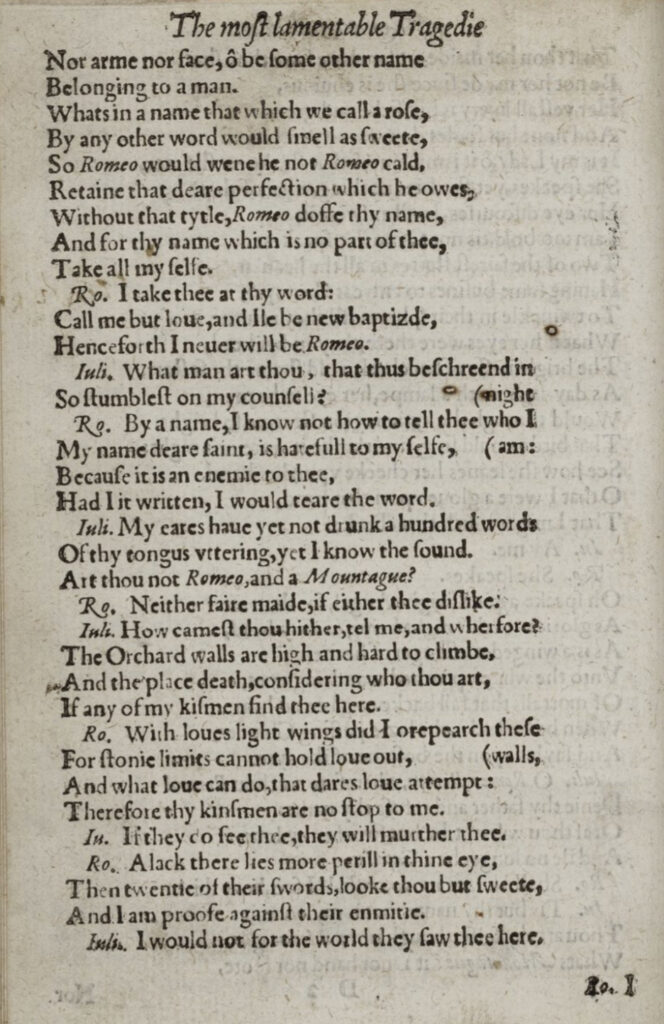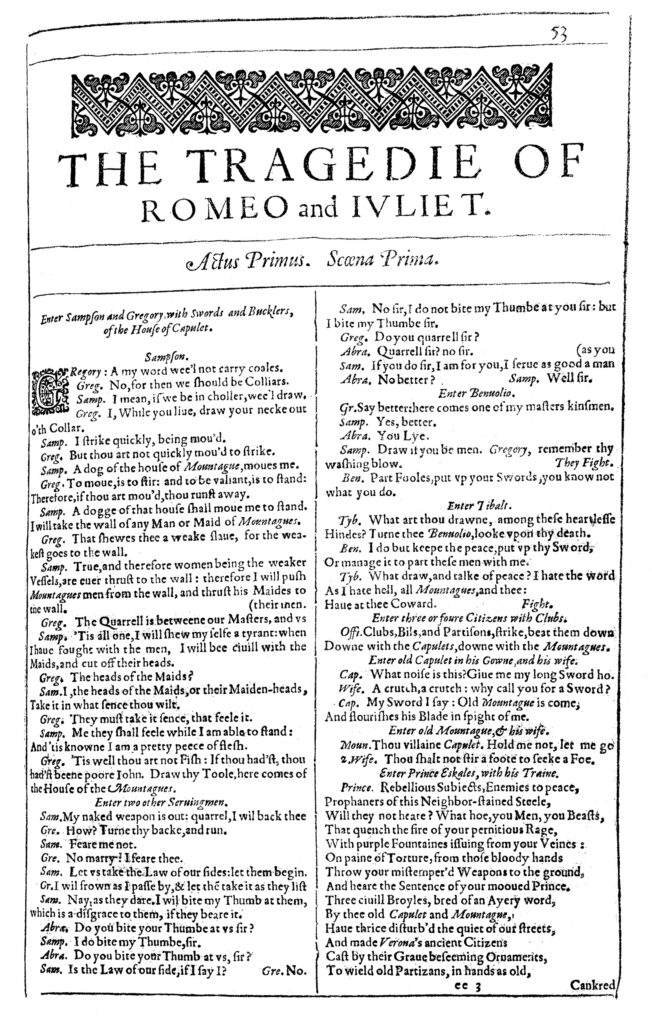By Barbara Mowat and Paul Werstine
Editors of the Folger Shakespeare Library Editions
Romeo and Juliet was printed in a variety of forms between its earliest appearance in 1597 and its inclusion in the first collection of Shakespeare’s plays, the First Folio of 1623.
In 1597 appeared An Excellent conceited Tragedie of Romeo and Iuliet, a quarto or pocket-size book that offers a version of the play markedly different from subsequent printings and from the play that most readers know. This version is only about two-thirds the length of later versions. It anticipates the language of these later versions quite closely (except for some apparent cuts) until near the end of Act 2. Then it offers a wedding scene that is radically different from the one in later texts. For the last three acts, the language of the First Quarto varies widely from that of later texts. While the plot is essentially the same, there sometimes is no sign at all of speeches found in later versions; and sometimes speeches appear in much abbreviated forms, which seem to most readers quite awkward in comparison to the fuller versions printed in 1599 and thereafter. This First Quarto has therefore been dubbed a “bad quarto.”
Explore the “bad quarto” of Romeo and Juliet (1597) in the Folger’s Digital Collections.
In 1599 the Second Quarto, often called the “good quarto,” was published. It was entitled The Most Excellent and lamentable Tragedie, of Romeo and Iuliet. Newly corrected, augmented, and amended. For the most part, this Second Quarto seems to have been printed from a manuscript containing the fuller version of the play that most readers know. Yet there are also undeniable signs that the printer of the Second Quarto consulted the First Quarto.
Explore the “good quarto” of Romeo and Juliet (1599) in the Folger’s Digital Collections.

From the Folger Shakespeare Library collection.

From the Folger Shakespeare Library collection.
For a short stretch (1.2.55–1.3.37), the Second Quarto seems to be no more than a reprint of the First Quarto. In 1609 a Third Quarto was reprinted from the Second.
Explore the Third Quarto of Romeo and Juliet (1609) in the Folger’s Digital Collections.
A Fourth Quarto, undated, was reprinted from the Third. This Fourth Quarto has been dated by Carter Hailey as having been printed in 1623. Its printer appears to have consulted the First Quarto for some corrections and word choices.
The First Folio version appeared in 1623. It reprinted the Third Quarto, but its printer’s copy must have been annotated by someone, because the Folio departs from the Third Quarto in ways that seem beyond the capacities of mere typesetters.
Recent editors have been virtually unanimous in their selection of the Second Quarto as the basis for their editions. In the latter half of the twentieth century it was widely assumed that (except for occasional consultation of the First Quarto) the Second Quarto was printed from Shakespeare’s own manuscript. In contrast, the First Quarto has been said to reproduce an abridged version put together from memory by actors who had roles in the play as it was performed outside London. Some editors have become so convinced of the truth of such stories about the First Quarto as to depend on it as a record of what was acted. Nevertheless, as today’s scholars reexamine the narratives about the origins of the printed texts, we discover that these narratives are based either on questionable evidence or sometimes on none at all, and we become more skeptical about ever identifying how the play assumed the forms in which it came to be printed.
The present edition is based on a fresh examination of the early printed texts rather than upon any modern edition.1 It offers readers the text as it was printed in the Second Quarto (except for the passage reprinted in the Second Quarto from the First; there this edition follows the First Quarto). But the present edition offers an edition of the Second Quarto because it prints such editorial changes and such readings from other early printed versions as are, in the editors’ judgment, needed to repair errors and deficiencies in the Second Quarto. Except for occasional readings and except for the single reprinted passage, this edition ignores the First Quarto because the First Quarto is, for the most part, so widely different from the Second.
For the convenience of the reader, we have modernized the punctuation and the spelling of the Second Quarto. Sometimes we go so far as to modernize certain old forms of words; for example, when a means “he,” we change it to he; we change mo to more, and ye to you. It is not our practice in editing any of the plays to modernize words that sound distinctly different from modern forms. For example, when the early printed texts read sith or apricocks or porpentine, we have not modernized to since, apricots, porcupine. When the forms an, and, or and if appear instead of the modern form if, we have reduced and to an but have not changed any of these forms to their modern equivalent, if. We also modernize and, where necessary, correct passages in foreign languages, unless an error in the early printed text can be reasonably explained as a joke.
Whenever we change the wording of the Second Quarto or add anything to its stage directions, we mark the change by enclosing it in superior half-brackets (⌜ ⌝). We want our readers to be immediately aware when we have intervened. (Only when we correct an obvious typographical error in the Second Quarto does the change not get marked.) Whenever we change the Second Quarto’s wording or its punctuation so that meaning changes, we list the change in the textual notes, even if all we have done is fix an obvious error.
We correct or regularize a number of the proper names, as is the usual practice in editions of the play. “Mountague” becomes “Montague,” for example, and the Prince’s name, “Eskales,” is printed as “Escalus.” Although neither Lady Montague nor Lady Capulet receives the honorific title “Lady” in the early printed versions of the play, the title is traditional in editions and is consistent with the social relations of the families as these are depicted both in the play and in its source. Therefore we refer to these characters as “Lady Montague” and “Lady Capulet.”
This edition differs from many earlier ones in its efforts to aid the reader in imagining the play as a performance. Thus stage directions are written with reference to the stage. For example, we do not describe Romeo and Juliet at their parting in Act 3 as being “at the window” (the First Quarto’s stage direction) because there is unlikely to have been an actual window above Shakespeare’s stage. Instead, we follow the Second Quarto and describe them simply as “aloft,” i.e., in the gallery above the stage.
Whenever it is reasonably certain, in our view, that a speech is accompanied by a particular action, we provide a stage direction describing the action. (Occasional exceptions to this rule occur when the action is so obvious that to add a stage direction would insult the reader.) Stage directions for the entrance of characters in mid-scene are, with rare exceptions, placed so that they immediately precede the characters’ participation in the scene, even though these entrances may appear somewhat earlier in the early printed texts. Whenever we move a stage direction, we record this change in the textual notes. Latin stage directions (e.g., Exeunt) are translated into English (e.g., They exit).
We expand the often severely abbreviated forms of names used as speech headings in early printed texts into the full names of the characters. We also regularize the speakers’ names in speech headings, using only a single designation for each character, even though the early printed texts sometimes use a variety of designations. Variations in the speech headings of the early printed texts are recorded in the textual notes.
In the present edition, as well, we mark with a dash any change of address within a speech, unless a stage direction intervenes. When the –ed ending of a word is to be pronounced, we mark it with an accent. Like editors for the last two hundred years and more, we display metrically linked lines in the following way:
Good morrow, cousin.
ROMEO Is the day so young?
(1.1.163–64)
However, when there are a number of short verse-lines that can be linked in more than one way, we do not, with rare exceptions, indent any of them.

